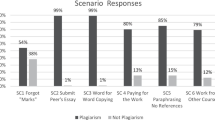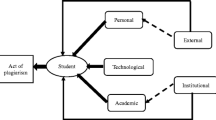Abstract
Although Chinese university students’ perceptions of plagiarism have been extensively investigated, those of their teachers have been surprisingly under-researched. This study sought to address this gap by investigating 112 Chinese university English teachers’ knowledge of and attitudes towards plagiarism. While 57 participating teachers had overseas academic experience, the remaining ones received all their education in mainland China. They completed a perceptions of plagiarism survey that elicited their knowledge of several common forms of plagiarism in Anglo-American academia, perceptions of various possible causes of plagiarism, and attitudes towards plagiarism induced by different causes and plagiarism in general. The study found that the teachers reported varying knowledge of different types of transgressive textual practices, variegated perceptions of the different causes of plagiarism, but clearly punitive attitudes towards plagiarism. It also revealed significant differences between teachers with and without overseas academic experience in knowledge of and stances on plagiarism. These findings highlight the complexity of plagiarism as an intertextual phenomenon and point to the important role of cultural practices and academic socialisation in shaping perceptions of it.
Similar content being viewed by others
Notes
In this study, “Anglo-American” is used as an adjective to denote cultural institutions and norms in such English-speaking countries as Australia, Canada, New Zealand, the UK, and the USA, which have a shared cultural heritage and a common ethnolinguistic identity.
Despite our best effort to match the overseas-trained and the home-trained teachers for key demographical characteristics, we could not completely rule out the possibility that prior to their participation in the in-service teacher training programme the overseas-trained teachers differed from their home-trained counterparts in other aspects that might have been relevant to their perceptions of plagiarism.
Strictly speaking, Singapore is not an Anglo-American society. Because of its history as a British colony and the dominant status of English as a working language and the medium of instruction, the educational system of the nation-state has been under Anglo-American influences, and its universities follow Anglo-American academic standards and practices.
The instrument is available from the authors upon request.
References
Angélil-Carter, S. (2000). Stolen language? Plagiarism in writing. Harlow: Longman.
Ashworth, P., Freewood, M., & Macdonald, R. (2003). The student lifeworld and the meanings of plagiarism. Journal of Phenomenological Psychology, 34, 257–278.
Bacha, N. N., & Bahous, R. (2010). Student and teacher perceptions of plagiarism in academic writing. Writing & Pedagogy, 2, 251–280.
Bennett, R. (2005). Factors associated with student plagiarism in a post-1992 university. Assessment & Evaluation in Higher Education, 30, 137–162.
Bloch, J. (2008). Plagiarism across cultures: Is there a difference? In C. Eisner & M. Vicinus (Eds.), Originality, imitation, and plagiarism: Teaching writing in the digital age (pp. 219–230). Ann Arbor: University of Michigan Press.
Bloch, J. (2012). Plagiarism, intellectual property and the teaching of L2 writing. Bristol, UK: Multilingual Matters.
Chandrasegaran, A. (2000). Cultures in contact in academic writing: Students’ perceptions of plagiarism. Asian Journal of English Language Teaching, 10, 91–113.
Cohen, J. (1988). Statistical power analysis for the behavioral sciences (2nd ed.). Mahwah, NJ: Lawrence Erlbaum.
Colnerud, G., & Rosander, M. (2008). Academic dishonesty, ethical norms and learning. Assessment & Evaluation in Higher Education, 34, 505–517.
Currie, P. (1998). Staying out of trouble: Apparent plagiarism and academic survival. Journal of Second Language Writing, 7, 1–18.
Deckert, G. (1993). Perspectives on plagiarism from ESL students in Hong Kong. Journal of Second Language Writing, 2, 131–148.
DeVellis, R. F. (2003). Scale development: Theory and applications (2nd ed.). Thousand Oaks, CA: Sage.
Devlin, M., & Gray, K. (2007). In their own words: A qualitative study of the reasons Australian students plagiarize. Higher Education Research & Development, 26, 181–198.
Ehrich, J., Howard, S. J., Mu, C., & Bokosmaty, S. (2014). A comparison of Chinese and Australian university students’ attitudes towards plagiarism. Studies in Higher Education, 1–16. doi:10.1080/03075079.2014.927850.
Ellery, K. (2008). Undergraduate plagiarism: A pedagogical perspective. Assessment & Evaluation in Higher Education, 33, 507–516.
Flowerdew, J., & Li, Y. (2007a). Language re-use among Chinese apprentice scientists writing for publication. Applied Linguistics, 28, 440–465.
Flowerdew, J., & Li, Y. (2007b). Plagiarism and second language writing in an electronic age. Annual Review of Applied Linguistics, 27, 161–183.
Forsyth, D. R., Pope, W. R., & McMillan, J. (1985). Students’ reactions after cheating: An attributional analysis. Contemporary Educational Psychology, 10, 72–82.
Fowler, F. J. (2009). Survey research methods (4th ed.). Thousand Oaks, CA: Sage.
Franklyn-Stokes, A., & Newstead, S. E. (1995). Undergraduate cheating: Who does what and why? Studies in Higher Education, 20, 159–172.
Gu, Q., & Brooks, J. (2008). Beyond the accusation of plagiarism. System, 36, 337–352.
Gu, Q., & Schweisfurth, M. (2006). Who adapts? Beyond cultural models of ‘the’ Chinese learner. Language, Culture and Curriculum, 19, 74–89.
Hard, S. F., Conway, J. M., & Moran, A. C. (2006). Faculty and college student beliefs about the frequency of student academic misconduct. The Journal of Higher Education, 77, 1058–1080.
Hayes, N., & Introna, L. (2005). Cultural values, plagiarism, and fairness: When plagiarism gets in the way of learning. Ethics and Behavior, 15, 213–231.
Hopwood, C. J., & Donnellan, M. B. (2010). How should the internal structure of personality inventories be evaluated? Personality and Social Psychology Review, 14, 332–346.
Howard, R. M. (1999). Standing in the shadow of giants: Plagiarists, authors, collaborators. Stamford, CT: Ablex.
Hu, G., & Lei, J. (2012). Investigating Chinese university students’ knowledge of and attitudes toward plagiarism from an integrated perspective. Language Learning, 62, 813–850.
Institute of International Education. (2013). Top 25 places of origin of international students, 2011/12-2012/13. Open doors report on international educational exchange. Retrieved 22 September 2014 from http://www.iie.org/opendoors.
Introna, L., Hayes, N., Blair, L., & Wood, E. (2003). Cultural attitudes towards plagiarism. Lancaster, UK: Lancaster University.
Kwong, T., Ng, H., Mark, K., & Wong, E. (2010). Students’ and faculty’s perception of academic integrity in Hong Kong. Campus-Wide Information Systems, 27, 341–355.
Lei, J., & Hu, G. (2014). Chinese ESOL lecturers’ stance on plagiarism: Does knowledge matter? ELT Journal, 68, 41–51.
Li, Y. (2007). Apprentice scholarly writing in a community of practice: An “intraview” of an NNES graduate student writing a research article. TESOL Quarterly, 41, 55–79.
Liu, D. (2005). Plagiarism in ESOL students: Is cultural conditioning truly the major culprit? ELT Journal, 59, 234–241.
Marshall, S., & Garry, M. (2005). How well do students really understand plagiarism? In H. Goss (Ed.), Proceedings of the 22nd annual conference of the Australasian society for computers in learning in tertiary education (pp. 457–467). Brisbane: Queensland University of Technology.
Marshall, S., & Garry, M. (2006). NESB and ESB students’ attitudes and perceptions of plagiarism. International Journal for Educational Integrity, 2, 26–37.
Matalene, C. (1985). Contrastive rhetoric: An American writing teacher in China. College English, 47, 789–808.
Maxwell, A., Curtis, G. J., & Vardanega, L. (2008). Does culture influence understanding and perceived seriousness of plagiarism? International Journal of Educational Integrity, 4, 24–40.
McGowan, U. (2010). Redefining academic teaching practice in terms of research apprenticeship. In M. Devlin, J. Nagy & A. Lichtenberg (Eds.), Research and development in higher education: Reshaping higher education (Vol. 33, pp. 481–489). Melbourne: Higher Education Research and Development Society of Australia.
McGowan, S., & Lightbody, M. (2008). ‘Another chance to practice’: Repeating plagiarism education for EAL students within a discipline context. International Journal for Educational Integrity, 4, 16–30.
Newstead, S., Franklyn-Stokes, A., & Armstead, P. (1996). Individual differences in student cheating. Journal of Educational Psychology, 88, 229–241.
Park, C. (2003). In other (people’s) words: Plagiarism by university students—literature and lessons. Assessment & Evaluation in Higher Education, 28, 471–488.
Pennycook, A. (1996). Borrowing others’ words: Text, ownership, memory, and plagiarism. TESOL Quarterly, 30, 201–230.
Phan, L. H. (2006). Plagiarism and overseas students: Stereotypes again? ELT Journal, 60, 76–78.
Pickard, J. (2006). Staff and student attitudes to plagiarism at University College Northampton. Assessment & Evaluation in Higher Education, 31, 215–232.
Pincus, H. S., & Schmelkin, L. P. (2003). Faculty perceptions of academic dishonesty: A multidimensional scaling analysis. The Journal of Higher Education, 74, 196–209.
Pittam, G., Elander, J., Lusher, J., Fox, P., & Payne, N. (2009). Student beliefs and attitudes about authorial identity in academic writing. Studies in Higher Education, 34, 153–170.
Rinnert, C., & Kobayashi, H. (2005). Borrowing words and ideas: Insights from Japanese L1 writers. Journal of Asian Pacific Communication, 15, 31–55.
Sapp, D. A. (2002). Towards an international and intercultural understanding of plagiarism and academic dishonesty in composition: Reflections from the People’s Republic of China. Issues in Writing, 13, 58–79.
Selwyn, N. (2008). ‘Not necessarily a bad thing…’: A study of online plagiarism amongst undergraduate students. Assessment & Evaluation in Higher Education, 33, 465–479.
Shen, F. (1989). The classroom and the wider culture: Identity as a key to learning English composition. College Composition and Communication, 40, 459–466.
Shi, L. (2004). Textual borrowing in second-language writing. Written Communication, 21, 171–200.
Shi, L. (2006). Cultural backgrounds and textual appropriation. Language Awareness, 15, 264–282.
Shi, L. (2012). Originality of expression and formal citation practices: Perceptions of students and professors. Writing & Pedagogy, 4, 43–67.
Song-Turner, H. (2008). Plagiarism: Academic dishonesty or ‘blind spot’ of multicultural education? Australian Universities’ Review, 50, 39–50.
Sowden, C. (2005). Plagiarism and the culture of multilingual students in higher education abroad. ELT Journal, 59, 226–233.
Spack, R. (1997). The acquisition of academic literacy in a second language: A longitudinal case study. Written Communication, 14, 3–62.
Sun, Y.-C. (2009). Using a two-tier test in examining Taiwan graduate students’ perspectives on paraphrasing strategies. Asia Pacific Education Review, 10, 399–408.
Valentine, K. (2006). Plagiarism as literacy practice: Recognizing and rethinking ethical binaries. College Composition and Communication, 58, 89–109.
Wheeler, G. (2009). Plagiarism in the Japanese universities: Truly a cultural matter? Journal of Second Language Writing, 18, 17–29.
Wilkinson, J. (2009). Staff and student perceptions of plagiarism and cheating. International Journal of Teaching and Learning in Higher Education, 20, 98–105.
Yazici, A., Yazici, S., & Erdem, M. S. (2011). Faculty and student perceptions on college cheating: Evidence from Turkey. Educational Studies, 37, 221–231.
Yeo, S. (2007). First-year university science and engineering students’ understanding of plagiarism. Higher Education Research & Development, 26, 199–216.
Author information
Authors and Affiliations
Corresponding author
Rights and permissions
About this article
Cite this article
Lei, J., Hu, G. Chinese university EFL teachers’ perceptions of plagiarism. High Educ 70, 551–565 (2015). https://doi.org/10.1007/s10734-014-9855-5
Published:
Issue Date:
DOI: https://doi.org/10.1007/s10734-014-9855-5




